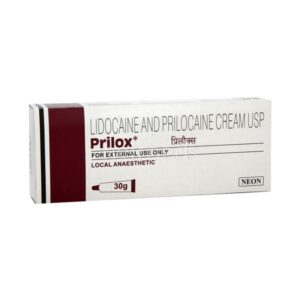PRILOCAINE + LIGNOCAINE
Prilocaine: Prilocaine is a local anesthetic drug that is commonly used for numbing the skin and tissues during minor surgical procedures or dental work. It belongs to the amide class of local anesthetics.
The primary use of prilocaine is to provide pain relief or numbness for procedures such as suturing wounds, removing moles or skin tags, dental fillings, or dental extractions. It can also be used for epidural anesthesia during childbirth and as a nerve block for certain surgical procedures.
The mechanism of action of prilocaine involves blocking the initiation and conduction of nerve impulses. This is achieved by inhibiting the influx of sodium ions through the voltage-gated sodium channels in the nerve cell membranes. By reducing the ability of nerves to transmit pain signals, prilocaine produces a temporary loss of sensation or numbness in the area it is applied.
The recommended dose of prilocaine varies depending on the type of procedure and the patient’s age, weight, and overall health. It is typically administered as a cream or gel for topical application, as an injection for local anesthesia, or as an epidural injection for regional anesthesia.
As with any medication, prilocaine has the potential to cause side effects. Common side effects include burning or stinging at the site of application, mild skin irritation, or redness. Some individuals may experience allergic reactions such as rash, itching, or swelling. Rarely, prilocaine can cause severe allergic reactions, including anaphylaxis, which may require immediate medical attention. Overdose or excessive use of prilocaine can lead to systemic toxicity, manifesting as dizziness, lightheadedness, tremors, seizures, or cardiac abnormalities.
It is important to consult a healthcare professional before using prilocaine and to follow their instructions carefully to ensure safe and effective use.
Lignocaine: Lignocaine, also known as lidocaine, is a local anesthetic medication commonly used to numb or block pain during medical procedures or surgeries. It belongs to the class of drugs called amide local anesthetics.
The mechanism of action of lignocaine involves blocking nerve signals in a specific area of the body, which prevents the sensation of pain. It does this by inhibiting the voltage-gated sodium channels in the nerve cell membranes, thereby reducing the initiation and conduction of nerve impulses.
Lignocaine can be administered in various forms, including injections, topical creams, gels, sprays, or as a patch. The dosage and administration depend on various factors such as the type and severity of the pain, the patient’s age, weight, and medical condition. The dosage is typically tailored to each individual, and it is important to follow the instructions provided by the healthcare professional.
Common side effects of lignocaine may include temporary numbness or loss of sensation, skin irritation or rash at the application site, drowsiness, dizziness, confusion, headache, nausea, and vomiting. These side effects are generally mild and transient.
In some cases, lignocaine can cause more serious side effects, although they are relatively rare. These may include allergic reactions like hives, itching, difficulty breathing, swelling of the face, lips, tongue, or throat. If any of these severe side effects occur, immediate medical attention should be sought.
It is important to note that lignocaine should not be used by individuals who are allergic to amide-type local anesthetics or any other ingredients present in the formulation. Additionally, lignocaine should be used with caution in individuals with certain underlying medical conditions such as heart rhythm disorders, liver disease, or reduced liver function.
Overall, lignocaine is a widely used local anesthetic medication with a well-established safety profile when used as directed. However, it is essential to discuss any concerns or potential interactions with other medications or medical conditions with a healthcare professional before using lignocaine.

